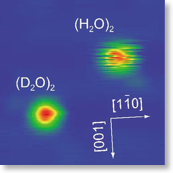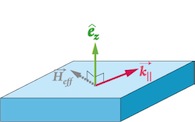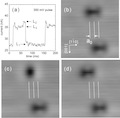2008
Toying with molecules
08/08/08 08:08 Filed in: single molecules | STM
Quantum dynamics of hydrogen bonds
01/04/08 12:00 Filed in: single molecules
 Water molecules are bound each other by hydrogen bond. In liquid water, three-dimensional networks of water moledules, formed by hydrogen bond, are rapidly changing their structure by incessant annihiration and re-creation of hydrogen bonds. It is believed that the chemical reaction in aqueous solution including those in vivo are influenced by the hydrogen bond.
Water molecules are bound each other by hydrogen bond. In liquid water, three-dimensional networks of water moledules, formed by hydrogen bond, are rapidly changing their structure by incessant annihiration and re-creation of hydrogen bonds. It is believed that the chemical reaction in aqueous solution including those in vivo are influenced by the hydrogen bond. Kumagai and Okuyama in our group succeeded in observing in real space the dynamics of hydrogen-bond alteration in water-dimer clusters isolated on a metal surface. They even revealed how the hydrogen bond alteration is governed by quantum mechanical tunneling effect....
Read more...
A new member of Peierls transition
01/04/08 11:08 Filed in: phase transitions
Peierls transition refers to the phenomena in which metals undergo phase changes associated with Fermi surface instability and periodic lattice distortion due to the interaction of electrons and phonons at
k = 2k_F. R. E. Peierls proposed the mechanism in his famous Quantum Theory of Solids (1955) in order to elucidate why low-symmetry structures are stabilized in crystalline Sb and Bi. Later, phase transitions found in 1970s in materials with low-dimensional Fermi surfaces have shown to be driven by this mechanism.
Owing to intensive studies, it has been established that the qualitative behaviour of the Peierls transition is well characterized by the strength of electron-phonon coupling as a dominant parameter. Thus the transitions are more often categorised simply into two classes: weak-coupling and strong-coupling types.
Our study have shown that the classification scheme is not appropreate...
Read more...
A milestone to spin-polarized current
01/04/08 10:00 Filed in: Rashba effect
 Two dimensional electron gases are formed at semiconductor heterojunction. If you apply a potential gradient perpendicular the junction plane, a spin-orbit interaction in proportion to the potential gradient as well as two-dimensional wavevector k is excerted to the electrons. As a result the electron spin is quantized in the direction perpendicular to both the plane normal and k, thus splitting the energy band. This is called the Rashba-Bychkov effect (or, Rashba effect). An important point is that the “direction” of the spin is inverted when you invert the sign of the k vector....
Two dimensional electron gases are formed at semiconductor heterojunction. If you apply a potential gradient perpendicular the junction plane, a spin-orbit interaction in proportion to the potential gradient as well as two-dimensional wavevector k is excerted to the electrons. As a result the electron spin is quantized in the direction perpendicular to both the plane normal and k, thus splitting the energy band. This is called the Rashba-Bychkov effect (or, Rashba effect). An important point is that the “direction” of the spin is inverted when you invert the sign of the k vector....Read more...







